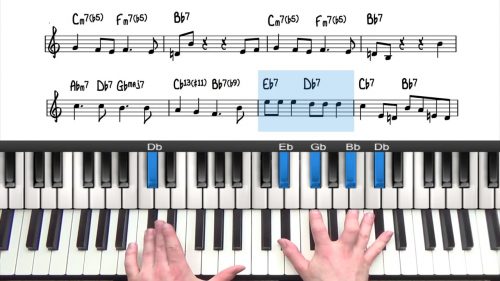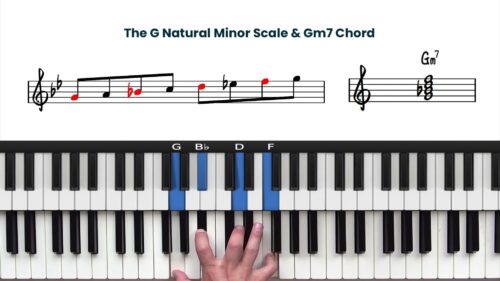Over the Rainbow – for Beginners
In this module we delve into the jazz standard "Over the Rainbow" and arrange the tune for beginner jazz piano players. This is the final tune in our course focused on the key of Eb major.
By now you will be more comfortable with Eb major harmony, including diatonic 7th chords and common diatonic chord progressions such as the 2-5-1 progression and 3-6-2-5-1 progression.
Over The Rainbow – AABA Form
"Over the Rainbow" follows an AABA form, with the A sections being completely identical. This repetition makes the song easier to learn and remember since mastering the first 8 bars means that we already know 75% of the tune. The repetition of the A section helps in quickly memorising the bulk of the melody and harmony.
Over The Rainbow – 7th Chords & Spread Voicings
We start with simple voicings and we isolate the 7th chords in root position to clearly visualise these important chord shapes and to get a feel for the basic structure before we move to more complex voicings.

To create smoother transitions between chords, we then introduce 2-handed voicings. This usually involves playing the root and 5th in the left hand and spreading the remaining chord tones between both hands. This technique minimises hand movement and creates a more balanced and cohesive sound as we transition between the chords.
251 & 36251 Progressions
We focus on identifying common jazz progressions and smooth transitions between chords. You will learn to recognise harmonic patterns such as the 3-6-2-5-1 progression and use them to build your knowledge of jazz piano chord voicings and chord progressions:

Visualising these progressions will help you to identify related blocks of harmony, making it easier to navigate the tune and create a smooth and flowing arrangement. The 36251 progression above appears 4 times in the form of Over The Rainbow and so it’s vitally important that you can recognise and navigate this progression.
Practice Tips
-
Repetition of A Sections: Practice the A section thoroughly, as it repeats 3 times during the tune. Learning the song's structure makes it easier to play the entire tune from memory.
-
Simple Voicings First: Start with simple 7th chords to familiarise yourself with the harmony before moving onto 2-handed spread voicings.
-
Two-Handed Voicings: Use two-handed voicings to create smoother transitions between chords. This technique reduces hand movement between the chord changes.
- Common Progressions: Learn to recognise common progressions such as 2-5-1s and 3-6-2-5-1s. Being able to visualise these related blocks of harmony is an essential skill.






